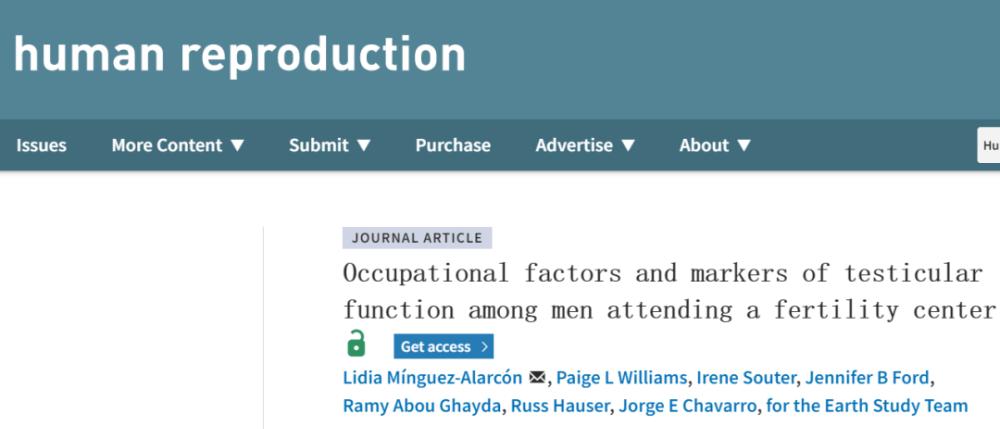Semen quality has declined in recent decades and is inversely associated with a high risk of common chronic diseases and mortality, highlighting its public health importance beyond fertility and reproduction. Most previous epidemiological literature on male fertility has focused on environmental exposures, dietary factors, and other relevant variables, with little attention paid to occupational factors.
On February 11, 2023, the team of Lidia Mínguez-Alarcón of Harvard University published a research paper entitled "Occupational factors and markers of testicular function among men attending a fertility center" online in Human Reproduction. The study answered the question of whether occupational factors correlated with testicular function indicators in men attending fertility centers. The results showed that of the men who completed the survey, 12 percent reported regularly lifting or moving heavy objects at work, 6 percent reported intense physical exertion at work, and 9 percent reported working at night or in shifts. Men who regularly lift or move heavy objects at work had 46% higher sperm concentration and 44% higher sperm count than men who never lifted or moved heavy objects at work. Similar results were also obtained for men who worked shifts and men who worked day shifts, as well as men with high physical exertion and men with low physical exertion.
The study also found that men who engaged in heavy/moderate physical activity at work had higher circulating testosterone concentrations than men who were mildly physically active, and men who frequently moved/lifted heavy objects at work had higher estradiol concentrations than men who never moved/lifted heavy objects. Men who worked late/shift had 24% higher testosterone levels and 45% higher levels of estradiol compared to men who worked day shifts. No correlations were observed for ejaculate volume, total motility, morphologically normal sperm, or serum FSH and LH concentrations. In summary, physically demanding jobs and shift or night shift occupations may be associated with higher testicular function in men, as measured by higher sperm concentration and count, and higher serum testosterone and estradiol levels. Confirmation of these findings in other non-fertility clinical study populations is warranted.

It is estimated that infertility affects about 10-15% of couples worldwide, with male factor infertility as defined by the World Health Organization (WHO) Semen Quality Reference Value, being the most common single cause, accounting for 40% of infertility cases.
In addition, the decline in semen quality over the past few decades has also been inversely correlated with a higher risk of common chronic diseases and mortality, highlighting the public health importance of semen quality beyond fertility and reproduction. Therefore, more attention needs to be paid to modifiable factors related to human fertility.
145 men in the Environmental and Reproductive Health (EARTH) study self-reported occupational factors adjusting circulating blood reproductive hormones (Image from Human Reproduction)
Most previous epidemiological literature on male fertility has focused on environmental chemicals, dietary factors, and other relevant variables such as BMI, waist circumference, and recreational physical activity, with little research on occupational factors. In this analysis, the authors investigated whether self-reported occupational factors (such as moving heavy objects, type of work shift, and level of physical exertion at work) were associated with repeated measures of semen quality among men seeking fertility care in Boston, Massachusetts, USA. Occupational exposure in some of these men was also assessed for correlation with circulating serum reproductive hormone levels.
The results showed that of the men who completed the survey, 12 percent reported regularly lifting or moving heavy objects at work, 6 percent reported intense physical exertion at work, and 9 percent reported working at night or in shifts. Men who regularly lift or move heavy objects at work had 46% higher sperm concentration and 44% higher sperm count than men who never lifted or moved heavy objects at work. Similar results were also obtained for men who worked shifts and men who worked day shifts, as well as men with high physical exertion and men with low physical exertion.
The study also found that men who engaged in heavy/moderate physical activity at work had higher circulating testosterone concentrations than men who were mildly physically active, and men who frequently moved/lifted heavy objects at work had higher estradiol concentrations than men who never moved/lifted heavy objects. Men who worked late/shift had 24% higher testosterone levels and 45% higher levels of estradiol compared to men who worked day shifts. No correlations were observed for ejaculate volume, total motility, morphologically normal sperm, or serum FSH and LH concentrations. In summary, physically demanding jobs and shift or night shift occupations may be associated with higher testicular function in men, as measured by higher sperm concentration and count, and higher serum testosterone and estradiol levels. Confirmation of these findings in other non-fertility clinical study populations is warranted.
In summary, the authors found that among men attending fertility centers, working hours and physically demanding work were associated with improvements in several indicators of testicular function. But further research is needed to confirm these results in other study populations and to elucidate the underlying mechanisms that explain these associations.